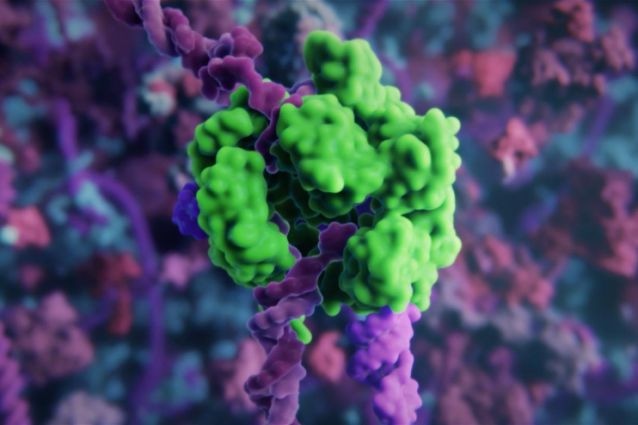Jul 18 2019
A study partnership between Tufts University and the Chinese Academy of Sciences (CAS) has resulted in the development of a considerably enhanced delivery mechanism for the CRISPR/Cas9 gene-editing technique in the liver; according to a research paper published recently in the journal Advanced Materials.
 The gene-editing molecules are difficult to deliver into cells from an external application. Biodegradable lipid nanoparticles deliver mRNA for the gene-editing kit instead. (Image credit: From animation by Visual Science and Skoltech [https://visual-science.com/crispr])
The gene-editing molecules are difficult to deliver into cells from an external application. Biodegradable lipid nanoparticles deliver mRNA for the gene-editing kit instead. (Image credit: From animation by Visual Science and Skoltech [https://visual-science.com/crispr])
The delivery employs biodegradable synthetic lipid nanoparticles that transport the molecular editing tools into the cell to precisely modify the cells’ genetic code with nearly 90% efficiency. The nanoparticles signify one of the most efficient CRISPR/Cas9 delivery tools described till date, according to the scientists, and could help overcome technical obstacles to allow gene-editing in a wide range of clinical therapeutic applications.
The CRISPR/Cas9 gene-editing system has become a dominant research tool revealing the function of numerous genes and is presently being investigated as a therapeutic tool for the treatment of different diseases. However, some technical obstacles remain before it can be applied for clinical applications.
CRISPR/Cas9 is a large molecular complex, comprising both a nuclease (Cas9) that can penetrate both strands of a targeted genomic sequence, and an engineered “single-guide” RNA (sgRNA) that scans the genome to help the nuclease find that particular sequence to be corrected. Since it is a big molecular complex, it is hard to deliver CRISPR/Cas9 straight into the nucleus of the cell, where it can perform its task.
Others have packed the editing molecules into polymers, viruses, and different kinds of nanoparticles to get them into the nucleus, but the low efficiency of transfer has restricted their use and effectiveness for clinical applications.
The lipid nanoparticles defined in the research compress messenger RNA (mRNA) encoding Cas9. Once the substances within the nanoparticles—including the sgRNA—are discharged into the cell, the cell’s protein-making mechanism takes control and forms Cas9 from the mRNA template, completing the gene-editing kit.
An exclusive feature of the nanoparticles is composed of synthetic lipids containing disulfide bonds in the fatty chain. When the particles penetrate the cell, the environment within the cell breaks open the disulfide bond to disassemble the nanoparticles and the substances are swiftly and efficiently discharged into the cell.
We are just starting to see human clinical trials for CRISPR therapies. There are many diseases that have long been intractable for which CRISPR therapies could offer new hope—for example sickle cell disease, Duchenne muscular dystrophy, Huntington’s disease, and even many cancers. Our hope is that this advance will take us another step toward making CRISPR an effective and practical approach to treatment.
Qiaobing Xu, Study Co-Corresponding Author and Associate Professor of Biomedical Engineering, Tufts University
The scientists applied the new technique to mice, aiming to decrease the presence of a gene coding for PCSK9, the loss of which is related to lower LDL cholesterol, and decreased risk of cardiovascular disease.
The lipid nanoparticles are one of the most efficient CRISPR/Cas9 carriers we have seen. We can actually knock down PCSK9 expression in mice with 80 percent efficiency in the liver, suggesting a real promise for therapeutic applications.
Ming Wang, Study Co-Corresponding Author and Professor, Beijing National Laboratory for Molecular Science, CAS
Along with the authors quoted above, the research was led by Ji Liu, graduate student and first author, of CAS, Institute of Chemistry, together with co-authors Jin Chang, Ying Jiang, Lanqun Mao, professors of the CAS, and Xiandi Meng, and Tianmeng Sun from The First Hospital and International Center of Future Science, Jilin University.
This research was partly supported by the National Key Research and Development Program of China (2017YFA0208100, 2016YFA0200104), and the National Science Foundation of China (21778056, 21790390, 21790391, 21621062 and 21435007). The research also received support from National Institutes of Health (UG3 TR002636-01 and R21 EB024041).